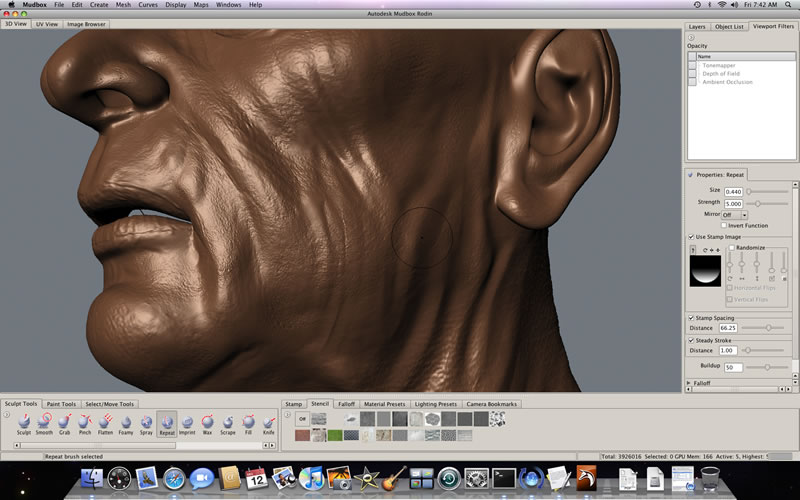Mudbox 2009 For Mac
The GTX 285 as an all-around 3D application card It may seem strange to test gaming cards with professional 3D applications since this would seem to be the domain of the high-end Quadro cards. But, as I showed in my, there are no Quadro optimizations for OS X applications, so you'll often get better performance with these cards in professional 3D apps due to their higher clock speed and increased memory bandwidth.

Also, because of the relative lack of workstation cards on the Mac, Autodesk supports gaming cards for use with Maya and Mudbox, whereas they only support their software for use with Quadros on the Windows and Linux side. In theory, this is a potential win-win for affordable, fast graphics with good support.
Unfortunately, it seems that's not always the case here. OpenGL Extension Viewer This test is not very punishing but it does a good job of showing you what OpenGL extensions are well optimized for each card. Later extensions are where most of the recent games get their flashy effects.
This will be handy to use as a reference for the later tests. The tests break down as follows:. OpenGL 1.1: use the standard OpenGL without extension usage. OpenGL 1.2: OpenGL test using GLlockarray and glDrawElement.

OpenGL 1.3: OpenGL using GLlockarray and multitexturing. OpenGL 1.4: OpenGL test using GLlockarray and multitexturing using a DOT3 shading and an ARB vertex program code. OpenGL 1.5: OpenGL test using Vertex Buffer Object.
OpenGL 2.0: OpenGL test using a GLSL 1.0 program. OpenGL 2.1: OpenGL test using pixel buffer object.
OpenGL Version GTX 285 4870 3870 OpenGL 1.1 1187 1621 1037 OpenGL 1.2 2290 1618 1062 OpenGL 1.3 2232 1404 841 OpenGL 1.4 1762 1413 935 OpenGL 1.5 1775 1215 908 OpenGL 2.0 816 1211 828 OpenGL 2.1 158 160 168 A mixed win for the GTX 285 with things trailing off at the end, where it gets beaten in the 2.0 and 2.1 tests by even the Radeon 3870. But overall it does well. Cinebench I don't really like Cinebench's OpenGL test since it's very basic in terms of polygon count and shaders, but there are a lot of Cinema 4D users with Mac Pros so I'll include it.
Not really very close, and the Radeon is noticeably faster with Cinema 4D. The very small difference between the 3870 and 4870 is a bit of a mystery, though, and could be chalked up to the basic nature of the scene and the low-res viewport. The GTX 285 score is odd considering that the much-slower G80-based Quadro FX 5600 gets 6414. I ran the test multiple times and this score was an average.
I would have included the FX 5600 card in other tests but I don't have it anymore—NVIDIA is sending me a Quadro 4800 soon so keep your eyes open for that card's score. Anyway, this low Cinebench score is definitely due to the GTX 285's drivers. Maya Bambo scene This is a big one for me personally since I do a lot of work in Maya. When you toss a ton of triangles with transparency and high-res textures into a scene, the differences between hardware becomes more apparent.
Autocad 2009 For Mac
The Radeon 3870 is finally getting owned because the 4870 and GTX 285 are much faster with heavy scenes. The advantage for the GTX (aside from the pure FPS win) is hard to quantify—it's just less jittery than the Radeon when interacting with Maya's viewport. Mudbox 2009 for Mac 8.5-million polygon model with diffuse, specularity and bump maps This is the mother of all stress tests since this scene comes in just under the 512MB memory limit of the Radeons and combines GLSL shader effects with an 8.5-million polygon character model. This type of polycount is typical of character sculpting, since normal maps are often generated from these very high-res meshes. The GTX 285 gets spanked badly here despite the 159GB/s bandwidth of the GTX 285 vs. The Radeon's 115 GB/s.
I wasn't necessarily surprised by this though, since the Quadros have the same problem and it hampers sculpting in Mudbox on the Mac. For comparison, the GTX 285 gets 284 FPS in Windows Vista. I know that the more polished Windows Mudbox code is likely also a factor, but the Radeon 3870—a year-old card that costs half as much—gets 97 FPS. So it's safe to say the GTX 285 drivers are at fault.
Even the 256MB 8600M in my MacBook Pro squeezes out 30 FPS. Mudbox isn't doing anything especially different from other applications—it is actually using game-like GLSL shaders to display content. This is why Mudbox performs so well on Windows Vista with gaming cards, NVIDIA has very polished OpenGL game drivers for Windows. I've been told by EVGA that NVIDIA is looking into addressing this performance problem, but it seems that ATI's well-rounded drivers for the Mac are putting it well ahead both here and with Cinema 4D OpenGL. GPU-based video processing Core Image and Final Cut RT filters are a couple real-world GPU tests used in video, so I stacked a few filters on some 1080p footage to test the cards. I also made sure to delete all Final Cut render cache files and disabled the 'render in background' option so that no hidden caching or processing would affect the benchmark.

Final Cut RT Extreme filter set on 1080p footage. A weird result, to say the least. The Radeon 4870 handily beats the GTX 285 with the multiple Core Image-based filters, but the 3870 beats them all. Not sure what we're seeing here, and I personally don't think it should carry too much weight since more developers are likely to focus on cross-platform OpenCL filter development in the future. That may seem largely dismissive of Core Image, but I think that developers want to be able to write filters for all platforms.
Shame on them for liking money. Finally, to benchmark a very basic GPU use, I opened Photoshop CS4 to see how many OpenGL-enhanced windows the GTX 285 could display. Since it has twice the amount of memory of the Radeon 4870, I was expecting it to scale at least a little. But all the cards, even the 3870, throw up the 'any new windows will be unaccelerated' warning after 16 windows.
CUDA and OpenCL The 300lb gorillas in any discussion of GPU-based computing are obviously CUDA and OpenCL. NVIDIA is pushing CUDA for obvious reasons, but the forthcoming Mac version of the Elemental H.264 encoder will be exclusively for the Quadro 4800. Luckily, Snow Leopard and OpenCL will open things up for GTX 285 users, and we are already seeing some powerful applications written to take advantage of this cross-platform, card-agnostic language. At this stage though, it's anyone's guess what OpenCL performance will be like between the competing high-end Mac cards. Conclusion There's no denying that for Windows gaming, the Geforce GTX 285 is a great card and the uncontested champ for Mac users who want the best framerate scores in demanding Windows games. The 1GB of RAM and OpenGL 3.0 compliance should mean that this card delivers for both games, 3D apps, and GPU-based processing for a while to come.
The consistent quietness of the card shouldn't be underestimated, and after popping my Radeon 4870 back into the Mac Pro to do some work in Mudbox, I began to really appreciate this feature. The $450 price of the GTX 285 is steep but, when you add $30 mini DisplayPort cost to Apple's exorbitant $350 price tag for the 512MB Radeon 4870, the Geforce GTX 285's price tag looks a little more reasonable. The only real catch are NVIDIA's OS X OpenGL drivers, which need to mature relative to the competition, since the GTX 285 is often beaten by the cheaper Radeons and even older-gen GeForces. That's the main thing stopping me from loving this card. Once the Mac drivers are polished, this card will definitely shine.
The good. Quiet, even under load. OpenGL 3.0-ready.
A lot of CUDA/OpenCL cores. Uses standard dual-link DVI connectors, not mini DisplayPort. Very fast in Windows games and applications. Cheapest 1GB card option for the Mac The bad. Mac drivers hamper this card's performance on the OS X side in a few cases.
Some CUDA applications are limited to use with expensive Quadro line The ugly. See Mudbox benchmark Page: 3.
Affects payment. Distinct fee schedule amount. G8 Monitored anesthesia care (MAC) for deep complex, complicated, or markedly invasive surgical procedure. Anesthesia: know when to use modifiers g8 and g9 for mac. G9 Monitored anesthesia care (MAC) for deep complex, complicated, or markedly invasive surgical procedure.